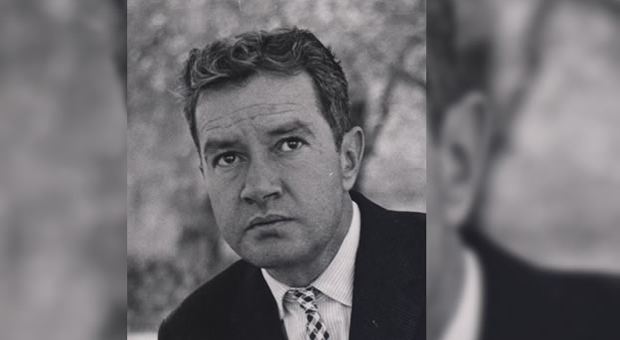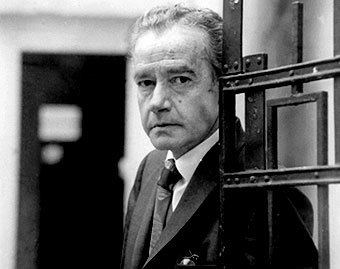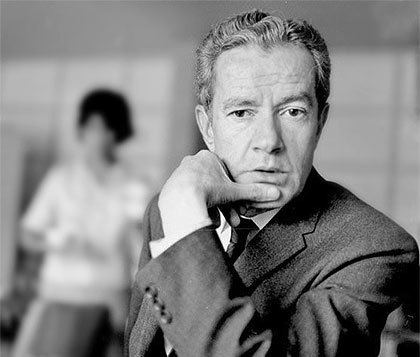Nationality Mexican Name Juan Rulfo | Role Writer | |
 | ||
Occupation Writer, screenwriter, photographer Spouse Clara Aparicio de Rulfo (m. 1948–1986) Movies Do You Hear the Dogs Barking?, Talpa, Pedro Paramo Awards Guggenheim Fellowship for Creative Arts, Latin America & Caribbean Books Pedro Paramo, El Llano en llamas, El Gallo De Oro, The burning plain - and, Juan Rulfo's Mexico Similar People Carlos Fuentes, Gabriel Garcia Marquez, Julio Cortazar, Octavio Paz, Jorge Luis Borges | ||
Biograf a de juan rulfo a 27 a os de su muerte
Juan Nepomuceno Carlos Pérez Rulfo Vizcaíno, best known as Juan Rulfo ([ˈxwan ˈrulfo] audio ; 16 May 1917 – 7 January 1986), was a Mexican writer, screenwriter and photographer. He is best known for two literary works, El Llano en llamas (1953), a collection of short stories, and the 1955 novel Pedro Páramo. Fifteen of the seventeen short stories in El Llano en llamas have been translated into English and published as The Burning Plain and Other Stories. This collection includes the popular tale "¡Diles que no me maten!" ("Tell Them Not to Kill Me!").
Contents
- Biograf a de juan rulfo a 27 a os de su muerte
- Juan rulfo by mexican institute of sound
- Early life
- Career
- Personal life
- Legacy
- References

The Juan Rulfo Foundation, which was established by Rulfo's family after his death, holds more than 6,000 negatives of his photographs.

Juan rulfo by mexican institute of sound
Early life

Rulfo was born in 1917 in Apulco, Jalisco (although he was registered at [San Gabriel, Jalisco]]), in the home of his paternal grandfather. Rulfo's birth year was often listed as 1918, because he had provided an inaccurate date to get into the military academy that his uncle, David Pérez Rulfo — a colonel working for the government — directed.

After his father was killed in 1923 and his mother died in 1927, Rulfo's grandmother raised him in Guadalajara, Jalisco. Their extended family consisted of landowners whose fortunes were ruined by the Mexican Revolution and the Cristero War of 1926–1928, a Roman Catholic integralist revolt against the government of Mexico following the Mexican Revolution.
Rulfo was sent to study in the Luis Silva School, where he lived from 1928 to 1932. He completed six years of elementary school and a special seventh year from which he graduated as a bookkeeper, though he never practiced that profession. Rulfo attended a seminary (analogous to a secondary school) from 1932 to 1934, but did not attend a university afterwards, as the University of Guadalajara was closed due to a strike and because Rulfo had not taken preparatory school courses.
Rulfo moved to Mexico City, where he entered the National Military Academy, which he left after three months. He then hoped to study law at the Universidad Nacional Autónoma de México. In 1936, Rulfo was able to audit courses in literature at the University, because he obtained a job as an immigration file clerk through his uncle.
Career
It was at the University that Rulfo first began writing under the tutelage of a coworker, Efrén Hernández. In 1944, Rulfo had co-founded the literary journal Pan. Later, he was able to advance in his career and travel throughout Mexico as an immigration agent. In 1946, he started as a foreman for Goodrich Euzkadi, but his mild temperament led him to prefer working as a wholesale traveling sales agent. This obligated him to travel throughout all of southern Mexico, until he was fired in 1952 for asking for a radio for his company car.
Rulfo obtained a fellowship at the Centro Mexicano de Escritores, supported by the Rockefeller Foundation. There, between 1952 and 1954, he was able to write two books.
The first book was a collection of harshly realistic short stories, El Llano en llamas (1953). The stories centered on life in rural Mexico around the time of the Mexican Revolution and the Cristero War. Among the best-known stories are "¡Diles que no me maten!" ("Tell Them Not To Kill Me!"), a story about an old man, set to be executed, who is captured by order of a colonel, who happens to be the son of a man whom the condemned man had killed about forty years ago; and "No oyes ladrar los perros" ("Don't You Hear the Dogs Barking(?)"), about a man carrying his estranged, adult, wounded son on his back to find a doctor.
The second book was Pedro Páramo (1955), a short novel about a man named Juan Preciado who travels to his recently deceased mother's hometown, Comala, to find his father, only to come across a literal ghost town ─ populated, that is, by spectral figures. Initially, the novel met with cool critical reception and sold only two thousand copies during the first four years; later, however, the book became highly acclaimed. Páramo was a key influence for Latin American writers such as Gabriel García Márquez. Pedro Páramo has been translated into more than 30 languages, and the English version has sold more than a million copies in the United States.
The book went through several changes in name. In two letters written in 1947 to his fiancée Clara Aparicio, he refers to the novel he was writing as Una estrella junto a la luna (A Star Next to the Moon), saying that it was causing him some trouble. During the last stages of writing, he wrote in journals that the title would be Los murmullos (The Murmurs). With the assistance of a grant from the Centro Mexicano de Escritores, Rulfo was able to finish the book between 1953 and 1954; it was published in 1955.
Between 1956 and 1958, Rulfo worked on a novella entitled El gallo de oro (The Golden Cockerel), which was not published until 1980. A revised and corrected edition was issued posthumously in 2010. The Fundación Rulfo possesses fragments of two unfinished novels, La cordillera and Ozumacín. Rulfo told interviewer Luis Harss that he had written and destroyed an earlier novel set in Mexico City.
From 1954 to 1957, Rulfo collaborated with "La comisión del rio Papaloapan", a government institution working on socioeconomic development of the settlements along the Papaloapan River. From 1962 until his death in 1986, he worked as editor for the National Institute for Indigenous People.
Personal life
Rulfo married Clara Angelina Aparicio Reyes (Mexico City, 12 August 1928) in Guadalajara, Jalisco, on 24 April 1948; they had four children, Claudia Berenice (Mexico City, 29 January 1949), Juan Francisco (Guadalajara, Jalisco, 13 December 1950), Juan Pablo (México City, 18 April 1955) and Juan Carlos Rulfo (México City, 24 January 1964).
Legacy
Gabriel García Márquez has said that he felt blocked as a novelist after writing his first four books and that it was only his life-changing discovery of Pedro Páramo in 1961 that opened the way to the composition of his masterpiece, One Hundred Years of Solitude. He noted that all of Rulfo's published writing, put together, "add up to no more than 300 pages; but that is almost as many and I believe they are as durable, as the pages that have come down to us from Sophocles".
A selection of Rulfo's photographs, accompanied by essays by Carlos Fuentes and others, has been published under the title of Juan Rulfo's Mexico.
